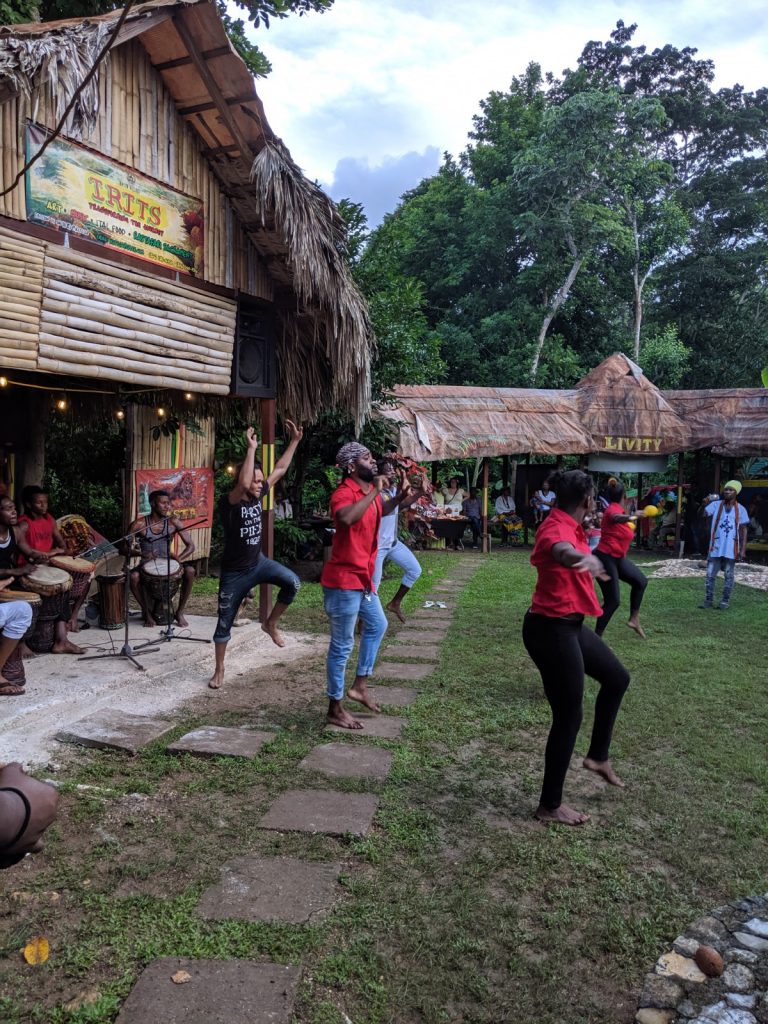On one of our last days visiting Jamaica we had the extreme pleasure of visiting The Rastafari Indigenous Village. Located just outside Montego Bay, Rastafari Indigenous Village is a living cultural center that offers an opportunity to experience the Rastafari way of life. Whether you choose a half or full-day tour, you’ll have the unique opportunity to connect with Rastafarians, and learn more about their culture and values. You’ll be introduced to drum makers who create traditional drums by hand, using techniques that have been passed down through generations and you can tour an organic vegetable and herb garden and learn more about why the Rastafari choose to follow a vegan diet, and what the benefits are. You can then have a meal with the Rastafari, and taste for yourself. A small gift shop offers traditional handicrafts and jewelry. The tour concludes with a performance of traditional drumming and singing in the center of the village. Drumming and chanting ceremonies are an important ritual in the elevation to the spiritual world of Rastafari. The Rastafari village was created 10 years ago as a cultural sharing center, healing ground, and sanctuary.
The food was some of the best we had to eat anywhere in Jamaica and was all Ital. Ital is food often celebrated by those in the Rastafari movement. It is compulsory in the Nyabinghi mansion though not in the Twelve Tribes of Israel or Remi mansions. The word derives from the English word “vital”, with the initial “v” removed. This emphasis on the letter “I” is done to many words in the Rastafari vocabulary to signify the unity of the speaker with all of nature. The primary goal of adhering to an Ital diet is to increase liveliness. Livity, or the life energy that Rastafari generally believe lives within all human beings, as conferred from “The Almighty”. There are several different interpretations of ital regarding specific foods, but the general principle is that ital food should be natural, or pure, and from the earth, so Rastafari usually avoid food which is chemically modified or contains artificial additives like color, flavourings, and preservatives.
As stated at the village:
“Rastafari is rightly associated with Jamaica, and the religion was born there back in the 1930’s. Rastafari view on horizontal society, equality with an identity where each is an owner onto themselves based on ability, with tourism as a tool to promote, protect and preserve the culture, an authentic Jamaican conscience for humanity.”
Rastafari is religious and political movement that combines Protestant Christianity, mysticism, and a pan-African political consciousness. Rastafari is an Abrahamic faith that adheres to much of The Bible, though Rastafaris worship Haile Selassie I, former emperor of Ethiopia. Technically speaking, Rastafari is a religious movement of Jamaican origin holding that blacks are the chosen people, that Emperor Haile Selassie of Ethiopia was the Messiah, and that black people will eventually return to their Africa. Rastafarians have distinctive codes of behavior and dress, including the wearing of dreadlocks, the smoking of cannabis, the rejection of Western medicine, and adherence to a diet that excludes pork, shellfish, and milk.
Arguably the best-known Rastafari is the late Bob Marley. The international music star introduced much of the world to the tenets of Rastafari, including the smoking of ganja, which the Rasta consider a sacred spiritual act. The sacramental smoking of ganja became legal in Jamaica in April 2015. While many Rastas choose not to cut their hair, and wear dreadlocks, it is not necessarily an absolute for believers. Irits is the village’s monthly acoustic gathering curated with the aim of creating balance by harmonizing music, food, healing, and art, with culture, preserving living aspects of Jamaican heritage, blending live music, an ital vegan cuisine and local artists and is an afternoon of healing therapies, African dancing, Kumina, traditional folklore and more.
We bought some Ganja grown in the village from one of the Rastafarian artists who live there and got to taste his cold pressed coconut oil THC tincture. We also got to taste some special Ganja soaked rum that had been brewing in a jar for over two years. It was insanely strong and tasted quite good. It also felt great when we rubbed it on our skin. Ganja soaked in rum and then used in tea is another traditional Jamaican cure-all. This special mixture fixes anything from headaches to bellyaches and some swear it also relieves cancer pains. We also picked up some Ganja soap that happens to be some of the best soap we’ve ever used.
This is a one of a kind experience that we cannot recommend enough. If you are ever anywhere even close to the area it is a must-visit type of place and you won’t regret it. You can check out the website at rastavillage.com to make your own arrangements for visiting the village.
Patrick Ian Moore
